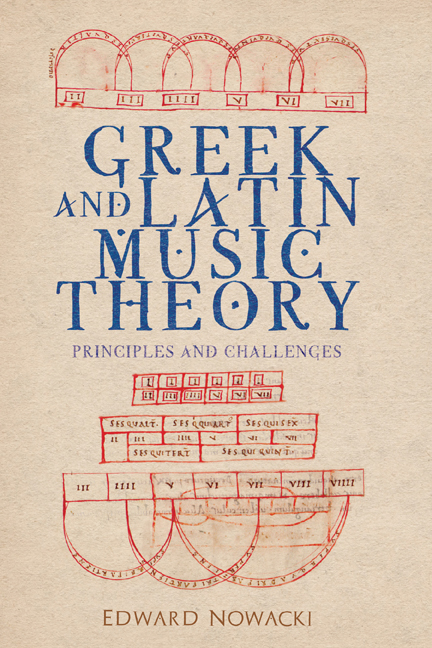8 - The Three Mathematical Means in the Theories of Euclid, Boethius, Glarean, and Zarlino
Published online by Cambridge University Press: 14 August 2020
Summary
The three means of ancient mathematical theory, the geometric, the arithmetic, and the harmonic, though infrequent in the tradition of Western music theory, nevertheless support some of the tradition's most foundational doctrines. Briefly defined, the arithmetic mean divides the difference between two numbers into equal differences, as 9 does when placed between 6 and 12. The geometric mean divides the difference into equal ratios, as 6 does when placed between 3 and 12, and the harmonic mean divides the difference into proportional differences, as 8 does when placed between 6 and 12. (The two differences—between 6 and 8 and between 8 and 12—form a ratio, 2:4, which is proportional to the ratio of the extremes, 6:12.)
The Geometric Mean
One of the earliest applications of the theory of the geometric mean occurs in the third proposition of the Euclidian Sectio canonis (ca. 300 b.c.e.). Whereas most of the propositions in this treatise seem to modern students of music theory to be truisms or tautological, the third proposition actually makes a claim about the nature of the real world with consequences for the discipline of music, especially for the tuning of musical instruments, that have lasted into modern times.
The proposition states that there can be no intermediate number that falls proportionally between the terms of a superparticular ratio (epimoric ratio in Greek). Elaborating, the proposition states that once a superparticular ratio has been reduced to its least proportional terms, so that the only common divisor is the unit, the difference between the terms, by definition, will also be a unit. And since finding an intermediate number within that difference would require dividing the unit, the attempt will fail, because division of the unit is impossible.
In reading this proposition, it is crucial to understand two things. First, an intermediate, or mean number falling proportionally between two extremes does not split the difference, but divides it so that the parts are proportional to each other, as when 2 divides the difference between 4 and 1, forming the two proportional ratios of 4:2 and 2:1. In the case of the whole tone measured by the superparticular ratio 9:8, a proportional mean would have to fall at some point between 9 and 8 such that the ratio of 9 to that number was proportional to the ratio of that number to 8.
- Type
- Chapter
- Information
- Greek and Latin Music TheoryPrinciples and Challenges, pp. 68 - 76Publisher: Boydell & BrewerPrint publication year: 2020

